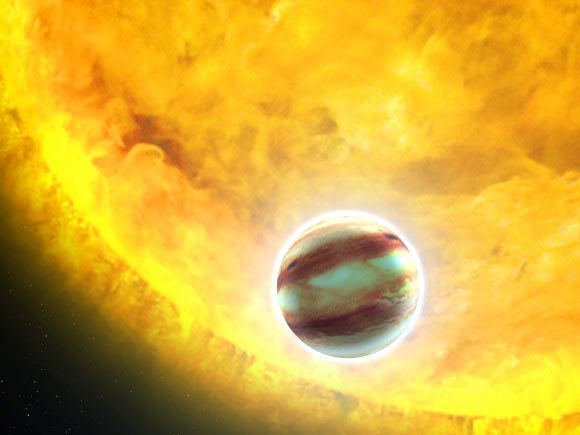Magnitude 8.3 Apparent magnitude (V) 8.3 | ||
 | ||
People also search for HD 13931, HD 8673, HD 16175, HD 5608 | ||
Exoplanet wasp 33b hd 15082b has a stratosphere
HD 15082 (also known as WASP-33) is a star located roughly 378 light years away in the northern constellation of Andromeda. The star is a Delta Scuti variable and a planetary transit variable. It is the first Delta Scuti variable known to host a planet. A hot Jupiter type extrasolar planet orbits this star with an orbital period of 1.22 days.
Contents
- Exoplanet wasp 33b hd 15082b has a stratosphere
- Planet
- Non Keplerian features of motion for HD 15082 b
- References
In common with many rapidly rotating stars of spectral type A, the stellar classification of HD 15082 is more challenging to discern. The hydrogen lines and effective temperature of the star are similar to spectral type A8, however the calcium II K line resembles that of an A5 star, and the metallic lines are more similar to an F4 star. The spectral type is thus written kA5 hA8 mF4. This suggests that HD 15082 is an Am star.
The exoplanet, HD 15082b (also known as WASP-33b) orbits so close to its star that its surface temperature is about 3,200 °C (5,790 °F).
Planet
In 2010, the SuperWASP project announced the discovery of an extrasolar planet, designated HD 15082 b, orbiting the star. The discovery was made by detecting the transit of the planet as it passes in front of its star, an event which occurs every 1.22 days. As the planet crosses the star's disc, it causes the rotational broadening signature in the star's spectrum to change, enabling the determination of the sky-projected angle between the star's equator and the orbital plane of the planet to be determined. (This differs from the Rossiter–McLaughlin effect which is observed for radial velocity measurements). For HD 15082 b, this angle is about 250 degrees, indicating that it is in a retrograde orbit. Limits from radial velocity measurements imply it has less than 4.1 times the mass of Jupiter.
June 2015 NASA reported the exoplanet has a stratosphere, and the atmosphere contains titanium oxide which creates the stratosphere. Titanium oxide is one of only a few compounds that is a strong absorber of visible and ultraviolet radiation, which heats the atmosphere, and able to exist in a gas-state in a hot atmosphere.
Non-Keplerian features of motion for HD 15082 b
In view of the high rotational speed of its parent star, the orbital motion of HD 15082 b may be affected in a measurable way by the huge oblateness of the star and effects of general relativity.
First, the distorted shape of the star makes its gravitational field deviate from the usual Newtonian inverse-square law. The same is true for the Sun, and part of the precession of the orbit of Mercury is due to this effect. However, it is estimated to be
Other effects will also be greater for HD 15082b. In particular, precession due to general relativistic frame-dragging should be
